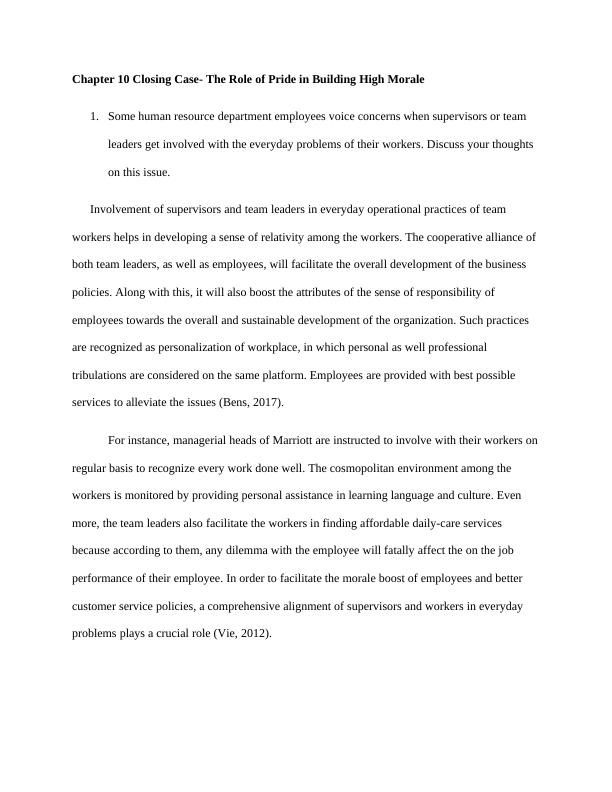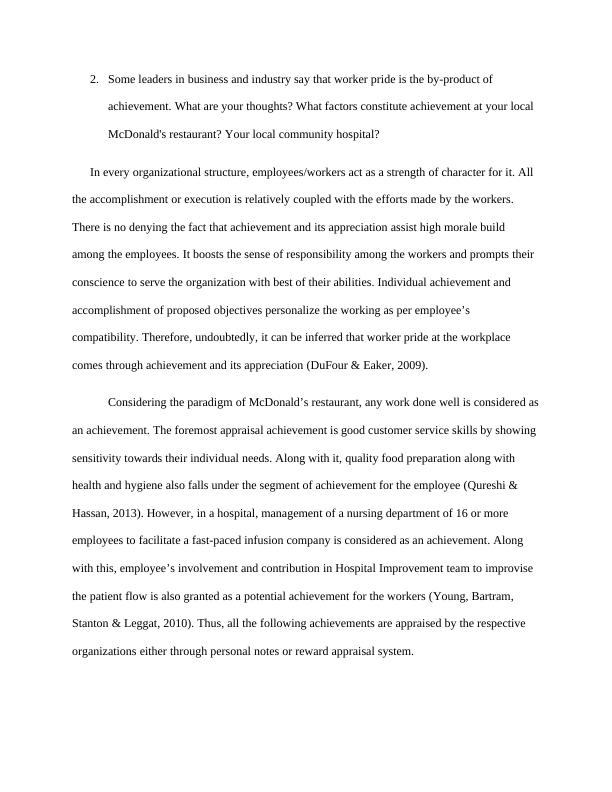Organizational Training Assignment
Added on 2021-04-16
8 Pages1731 Words237 Views
Running Head: ORGANIZATIONAL TRAININGOrganizational Training

Chapter 10 Closing Case- The Role of Pride in Building High Morale1.Some human resource department employees voice concerns when supervisors or team leaders get involved with the everyday problems of their workers. Discuss your thoughts on this issue.Involvement of supervisors and team leaders in everyday operational practices of team workers helps in developing a sense of relativity among the workers. The cooperative alliance of both team leaders, as well as employees, will facilitate the overall development of the business policies. Along with this, it will also boost the attributes of the sense of responsibility of employees towards the overall and sustainable development of the organization. Such practices are recognized as personalization of workplace, in which personal as well professional tribulations are considered on the same platform. Employees are provided with best possible services to alleviate the issues (Bens, 2017).For instance, managerial heads of Marriott are instructed to involve with their workers onregular basis to recognize every work done well. The cosmopolitan environment among the workers is monitored by providing personal assistance in learning language and culture. Even more, the team leaders also facilitate the workers in finding affordable daily-care services because according to them, any dilemma with the employee will fatally affect the on the job performance of their employee. In order to facilitate the morale boost of employees and better customer service policies, a comprehensive alignment of supervisors and workers in everyday problems plays a crucial role (Vie, 2012).

2.Some leaders in business and industry say that worker pride is the by-product of achievement. What are your thoughts? What factors constitute achievement at your local McDonald's restaurant? Your local community hospital?In every organizational structure, employees/workers act as a strength of character for it. All the accomplishment or execution is relatively coupled with the efforts made by the workers. There is no denying the fact that achievement and its appreciation assist high morale build among the employees. It boosts the sense of responsibility among the workers and prompts their conscience to serve the organization with best of their abilities. Individual achievement and accomplishment of proposed objectives personalize the working as per employee’s compatibility. Therefore, undoubtedly, it can be inferred that worker pride at the workplace comes through achievement and its appreciation (DuFour & Eaker, 2009).Considering the paradigm of McDonald’s restaurant, any work done well is considered asan achievement. The foremost appraisal achievement is good customer service skills by showing sensitivity towards their individual needs. Along with it, quality food preparation along with health and hygiene also falls under the segment of achievement for the employee (Qureshi & Hassan, 2013). However, in a hospital, management of a nursing department of 16 or more employees to facilitate a fast-paced infusion company is considered as an achievement. Along with this, employee’s involvement and contribution in Hospital Improvement team to improvise the patient flow is also granted as a potential achievement for the workers (Young, Bartram, Stanton & Leggat, 2010). Thus, all the following achievements are appraised by the respective organizations either through personal notes or reward appraisal system.

End of preview
Want to access all the pages? Upload your documents or become a member.
Related Documents
Organizational Behaviour Assignment Projectlg...
|12
|3418
|64
Managing McDonald's Australia: A Case Study Analysislg...
|9
|2071
|247
Report on Leadership of Global Hospitalitylg...
|12
|3720
|40
CHCDIV001 Work with diverse people - Assessmentslg...
|10
|1897
|378
MBWA Management by Wandering Aroundlg...
|4
|684
|19
Facilitate Continuous Improvement: Strategies and Toolslg...
|5
|798
|322
